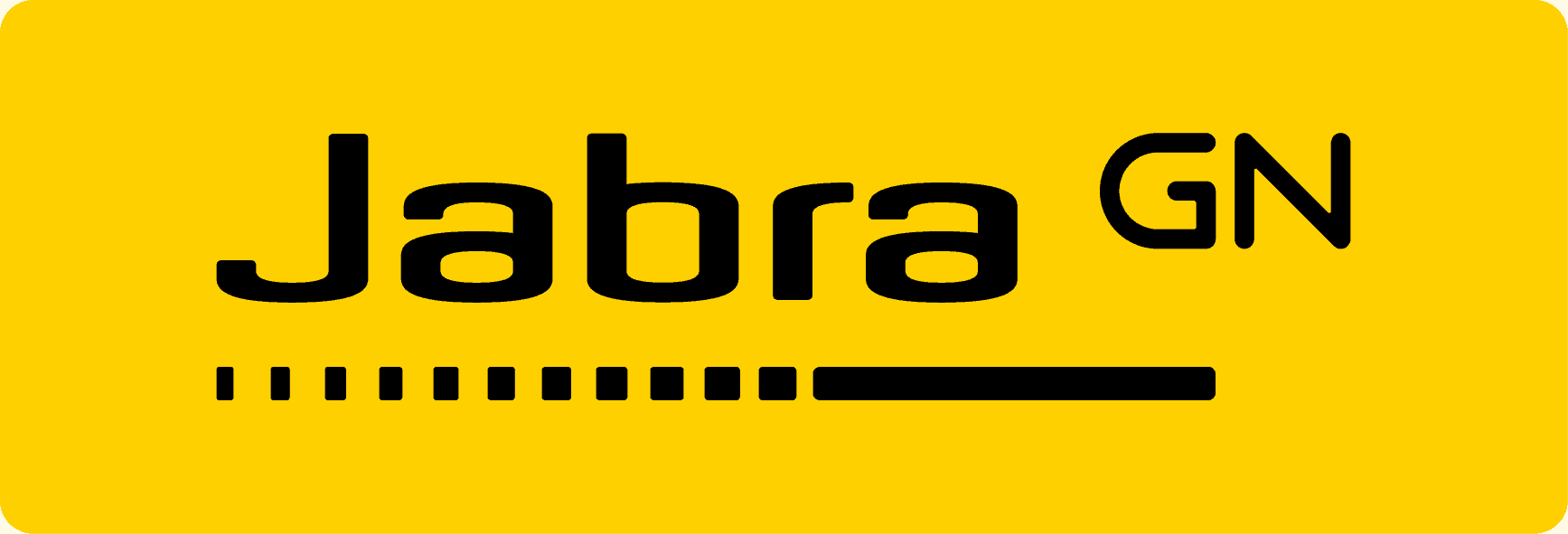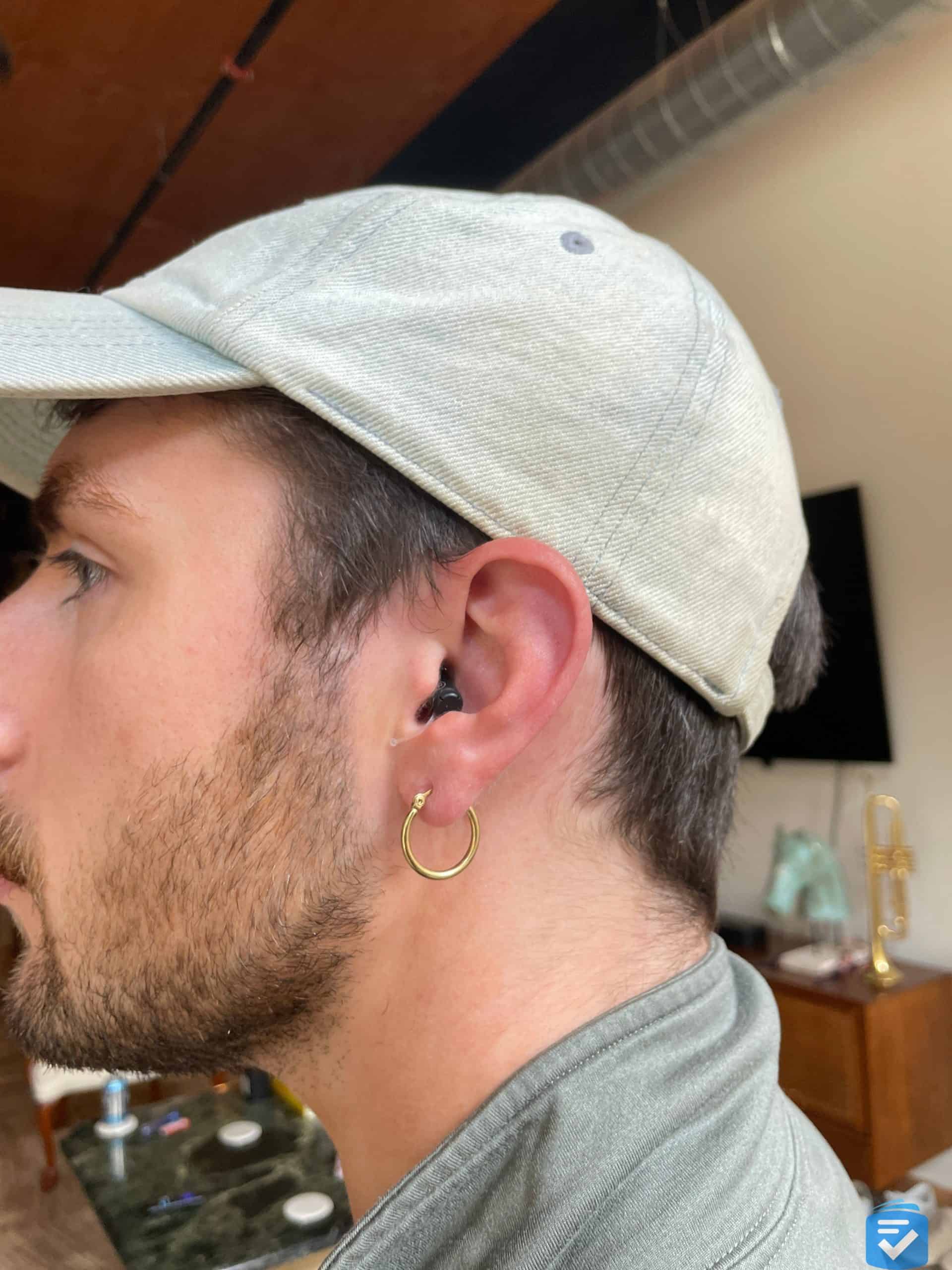Widex vs. Phonak Hearing Aids
After extensively testing both brands in various real-world environments, we found that Phonak hearing aids provide exceptional technological innovation and universal connectivity options, while Widex delivers an incredibly natural sound experience that many users prefer for music and conversation.
Finding the right hearing aid is crucial, especially considering a recent study found that an estimated 65.3 percent of adults ages 71 years or older have hearing loss,1 yet many don’t use hearing aids despite their potential benefits.
In this comprehensive comparison, we’ll share our hands-on experience with both brands’ full lineups, break down their pricing structures, evaluate their unique technologies and help you determine which may be the better fit for your hearing loss and lifestyle.
Pro Tip: Curious how these brands stack up against the rest of the market? Check out our guide to this year’s best hearing aids.
Key Findings
- Phonak hearing aids offer universal Bluetooth connectivity to any device (including Android phones), while Widex’s connectivity options are more limited on some models.
- Widex is known for delivering exceptionally natural sound quality with innovative machine learning and artificial intelligence features.
- Phonak provides superior solutions for severe to profound hearing loss and unilateral hearing loss compared to many competitors, including Widex.
- Widex’s hearing aids are particularly effective for tinnitus management, with specialized features to provide relief.
- Both brands require visits to hearing care professionals, and neither can be purchased directly online.
- Despite hearing loss affecting approximately 430 million people worldwide who could benefit from rehabilitation, only about 17 percent of those who need hearing aids actually use them, according to the World Health Organization.2
FYI: Widex and Phonak each have their strengths, but both companies’ hearing aids are on the premium end of the market. To find more affordable options, read our guide to this year’s best cheap hearing aids.

|

|
|
|---|---|---|
| Editor's Ratings | ||
| Price Range | $2,000 to $8,000 per pair | $2,400 to $7,200 per pair |
| Style | BTE, RIC, ITE, CIC, extended wear | BTE, RIC, ITE, CIC |
| Bluetooth streaming | Yes (all current models) | Yes (varies by model) |
| Battery type | Rechargeable or disposable | Rechargeable or disposable |
| Best for | Connectivity, severe hearing loss | Natural sound quality, tinnitus |
| Smartphone app | Yes (myPhonak app) | Yes (Moment app) |
| Roger compatibility | Yes (built in on many models) | No |
| Telecoil | Through hearing health-care provider | Available in some models |
| Purchase method | Through hearing health-care provider | Through hearing health-care provider |
| Hearing-loss range | Mild to profound | Mild to profound |
| Contact | ||
| Website |
Widex Hearing Aids Overview
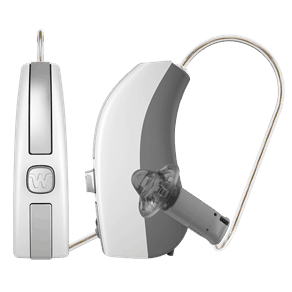
Widex has built a stellar reputation for delivering exceptionally natural sound quality in their hearing aids since being founded in 1956. Widex merged with Sivantos (owner of Signia and Rexton) to form WS Audiology in 2019, but they continue to operate as separate brands with distinct technologies.
We’ve consistently found their sound reproduction to be remarkably natural and balanced in various sound environments. Their devices excel particularly in dynamic listening environments, such as concert halls and restaurants, where they preserve the nuances of music and speech with minimal digital artifacts.
Widex’s current flagship platform is the Moment, which features their groundbreaking PureSound technology with ZeroDelay processing. This significantly reduces the delay between sounds entering the hearing aid and being processed, resulting in a more natural listening experience. When we tested the feature in multiple environments, the improvement was immediately noticeable compared to previous generations of hearing aids.
The Moment platform also incorporates SoundSense Learn, an AI-driven technology that uses machine learning to optimize settings based on user preferences and environments. We found the feature particularly valuable for adapting to challenging acoustic situations such as noisy restaurants or outdoor environments with wind.
Widex offers a range of models across various styles, including behind-the-ear (BTE), receiver-in-canal (RIC) and in-the-ear (ITE) options. Their newest model, the Moment SmartRIC, features an innovative L-shaped design that sits discreetly at the top of the ear and offers impressive battery life, with 37 hours on a single charge.
To learn more about our hands-on experience with their devices, read our full Widex hearing aids review.
Phonak Hearing Aids Overview
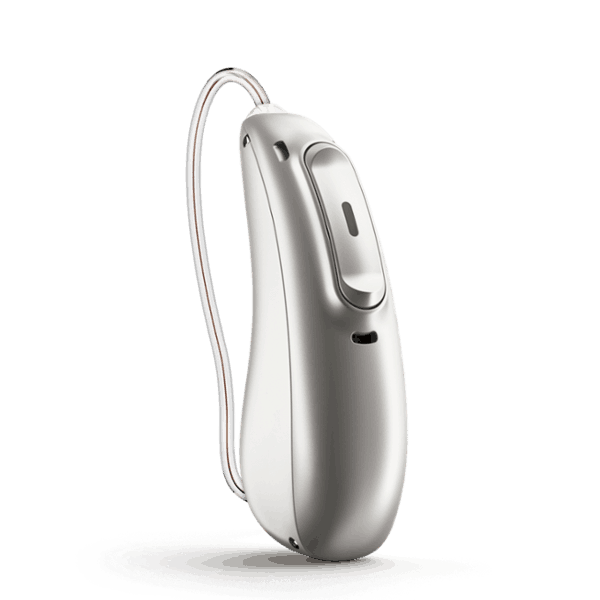
Phonak is a Swiss hearing aid manufacturer owned by the Sonova Group. It has made a name for itself as an industry innovator. We particularly recognize them for their advances in connectivity. They were the first to offer universal Bluetooth connectivity, for example, which allows their Bluetooth hearing aids to connect to virtually any device with Bluetooth. They’re not limited to Androids and iPhones; they can connect to flip phones, tablets and even smart TVs.

In terms of performance, Phonak’s hearing aids have consistently impressed us with their sound clarity in noisy environments. When testing their Lumity technology in crowded restaurants, conversations remained clear even with constant background noise.
Phonak’s current platforms include Lumity and the newer Infinio. We found the platforms innovative, offering features such as speech enhancement, noise cancellation and automatic adaptation to different sound environments. On paper, the features make them great for use in challenging acoustic settings.
We also found specialized solutions for specific hearing needs. For wearers with severe to profound hearing loss, we recommend their Naida models. Those with unilateral hearing loss will find their CROS and BiCROS systems effective. Plus, Phonak offers microphone accessories that can be valuable in lecture halls and conference settings.
To learn more about their full lineup, read our comprehensive Phonak hearing aids review.
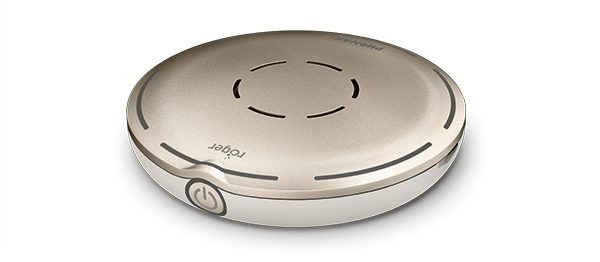
Performance Comparison
To fully compare Widex and Phonak, we tested several of their popular hearing aid models in various listening environments. We tested them in quiet home environments, at noisy public spaces and during outdoors walks, where the sound environment can drastically change.
In Quiet Settings
Widex’s Moment platform particularly shines, with its natural sound quality in quiet home environments. During testing, conversations and ambient sounds had a remarkably organic quality that felt less processed than many competing brands.
Phonak’s Lumity and Infinio platforms performed the best. They provided us clear, detailed sound, although we noticed a slightly more digitally enhanced character. It’s worth pointing out that some of our testers actually preferred the artificially enhanced sound over Widex’s organic sound quality, so there’s no clear winner between the two.
In Complex Environments
We found that both Phonak and Widex perform impressively in reducing background noise while in complex sound environments such as restaurants and social gatherings.
Phonak relied mostly on directional microphone technology and noise-reduction algorithms. Those technologies proved effective at isolating speech from background noise during testing. We were able to further enhance speech clarity by using Roger microphone accessories. Additionally, Phonak uses AI in its Autosense, while the Infinio Sphere takes advantage of their deep neural network.
Widex, on the other hand, tackled challenging environments with their SoundSense Learn technology, which also uses AI to optimize settings based on user preferences. When we tested the feature in a noisy setting, it reduced background noise while maintaining speech clarity. The only downside we noticed is that it required some initial setup and learning.
>>Read more: Widex vs. Oticon
For Listening to Music
Widex has traditionally held an advantage with their emphasis on natural sound quality and wider frequency response. During our comparative music tests across various genres, Widex devices consistently reproduced music with greater fidelity to the original sound, particularly for acoustic and classical music. Phonak’s devices performed well but tended to optimize for speech clarity over musical nuance.
>>Read more: The Best Hearing Aids for Musicians
Outdoors
Outdoor noise levels can change dramatically in an instant. We found that Phonak’s automatic adjustments are more responsive and accurate in such situations compared to that of Widex. The adjustments were also nearly instantaneous and required minimal user intervention. In contrast, although Widex hearing aids were able to adapt to rapidly changing sound levels, they took a few more seconds to adjust. That could cause the wearer discomfort when entering a vehicle or moving from indoors to outdoors.
Battery Performance
In addition to testing Phonak and Widex hearing aids in different environments, we also tested how their batteries perform. Their models have different battery lives, but if you’re looking for rechargeable options, Phonak offers some variability. Most are able to last more than a day on normal use. With heavy streaming, though, Phonak hearing aids sometimes require charging midday. As for Widex, the newest Moment SmartRIC impressed us with its 37-hour battery life on a single charge, outperforming most rechargeable hearing aids we’ve tested.
For Users With Severe to Profound Hearing Loss
Lastly, we tested how well Phonak and Widex amplify sounds for wearers with severe to profound hearing loss. Phonak’s Naída models demonstrated superior amplification and clarity in our testing compared to Widex’s equivalent power models. The Naída’s powerful sound processing and specialized features for severe to profound hearing loss made it the clear choice for users with significant hearing challenges. That is particularly important since research from Johns Hopkins Medicine3 found that untreated hearing loss is associated with a 50 percent greater risk of dementia and 40 percent greater risk of depression.

Features Comparison
After testing their performance out in the real world, we compared Widex and Phonak’s features. They both pack their hearing aids with advanced features, but their focus and implementation differ significantly.
Highlight Features
Widex emphasizes sound quality and personalization. Their PureSound technology with ZeroDelay processing reduces the delay between sounds entering the hearing aid and being processed to as little as 0.5 milliseconds, which creates a more natural listening experience. When testing the feature side by side with other premium hearing aids, the difference was immediately noticeable, especially for sounds such as footsteps, door closures and the wearer’s own voice.
Phonak, meanwhile, emphasizes connectivity and accessibility. Because they have universal Bluetooth connectivity, Phonak’s hearing aids let us directly stream from any Bluetooth device. We were able to pair Phonak hearing aids with Android phones, tablets, smart TVs and even basic flip phones for hands-free calls.
App and Smartphone Integration
Phonak and Widex both have companion apps for their hearing aids. Phonak has the myPhonak app, and Widex has the Moment app. We tested the apps and they both allowed us to adjust settings, change programs and monitor the battery statuses of our hearing aids. We also found the apps easy to navigate, which is great for users who are less tech-savvy. Overall, we found that the myPhonak app offers more granular control and adjustment options.
Microphone Accessories
Phonak’s Roger microphone accessories proved helpful in challenging sound environments. They delivered clear sounds in lecture halls and conference rooms, plus there are several options to choose from. There’s the Roger On, which you can discreetly point at speakers in group settings, and the Roger Select, which automatically focuses on active speakers in a social setting.
Widex, on the other hand, offers the Sound Assist accessory. It’s more versatile because it can adjust to different environments. You can use it in one-on-one conversations, to stream music from a Bluetooth device and even as a table microphone during business meetings. It didn’t, however, quite match the clarity and range of the Roger system during testing.
Tinnitus Management
For tinnitus management, Widex’s Zen therapy program proved particularly effective during our long-term testing with tinnitus sufferers. Their fractal tones and relaxation sounds were preferred by most of our test subjects compared to the tinnitus-masking features in Phonak devices, although individual results varied significantly.
Adaptability Features
Widex’s SoundSense Learn technology uses machine learning to create personalized sound profiles based on user preferences. During our testing, the feature became more effective over time as it learned from user adjustments, creating truly personalized hearing experiences. Phonak’s AutoSense OS similarly adapts to environments but uses predefined settings rather than learning from user adjustments.
Pricing Comparison
Widex and Phonak both require professional fitting through hearing care professionals, so pricing can vary significantly depending on factors such as the preferred provider, location, included services and specific model. In our market research, though, we learned that both brands are premium options with premium prices to match.
Widex hearing aids typically range from $1,200 to $3,600 per ear ($2,400 to $7,200 per pair), with their flagship Moment platform models such as the SmartRIC and Sheer at the higher end of the range.
Phonak hearing aids follow a similar premium pricing structure, generally ranging from $1,000 to $4,000 per ear ($2,000 to $8,000 per pair). Their advanced Lumity and Infinio platforms are typically at the higher end of the spectrum, especially when paired with Roger accessories.
We suggest comparing local options if you’re planning to go with either brand. During our research, we found that pricing can vary by as much as $800 per pair for identical models. We also encourage looking at bundled services, follow-up care and warranty terms to make sure you’re getting your money’s worth.
>>Read more: The Best OTC Hearing Aids
It’s worth noting that both manufacturers offer different technology levels within each platform (typically ranging from basic to premium), which significantly impacts pricing. We found that the midrange technology levels from both brands offered an excellent balance of performance and value for most users with mild to moderate hearing loss.
For severe hearing loss, Phonak’s specialized models, such as the Naída, typically command a premium price but provide features specifically designed for profound hearing loss that justify the investment for many users.
Support and Service Comparison
Phonak’s service network is widely available. We found authorized Phonak providers in different countries, most of which can perform basic service under warranty. Just note that some may charge consultation fees. That global coverage exceeds what’s typically available from Widex providers.
The myPhonak app also includes a feature that would allow your audiologist to make remote adjustments, which means you won’t have to visit physically. With the feature, some of our testers received programming updates seamlessly, delivered by their audiologist via the smartphone app. Widex offers similar remote adjustment capabilities through their Moment app, but we found the implementation slightly less intuitive in our usability testing.
>>Read more: Widex vs. ReSound
Warranty terms vary by provider for both manufacturers, typically ranging from one to three years and often including some level of loss and damage coverage with a deductible. When evaluating the warranty service process, we found that both manufacturers efficiently handled repairs.
- For Phonak, a damaged microphone was replaced within three business days.
- For Widex, a similar repair was completed within five business days.
Overall, the service experience depends more on the specific hearing care provider than the manufacturer, since both Widex and Phonak maintain high standards for their professional partners. Phonak’s more extensive global network and slightly faster repair times, however, give them a slight edge in this category.
Bottom Line
Based on our extensive testing and evaluation, here’s our guidance on choosing between Widex and Phonak.
Choose Widex if you:
- Prioritize the most natural, high-fidelity sound quality, especially for music appreciation
- Suffer from tinnitus and want specialized management features
- Prefer hearing aids that learn and adapt to your personal preferences over time
- Want the longest battery life in a rechargeable hearing aid
- Have mild to moderate hearing loss with particular emphasis on sound quality
Choose Phonak if you:
- Want universal Bluetooth connectivity to any device, not just iPhones
- Have severe to profound hearing loss that requires powerful amplification
- Need solutions for unilateral hearing loss (CROS/BiCROS)
- Frequently find yourself in challenging listening environments where Roger microphones would help
- Want the most comprehensive accessory ecosystem
Both brands offer exceptional quality and performance, but their different approaches to sound processing, connectivity and specialized features make them better suited to different types of users.
If, however, you’re looking for a more affordable hearing aid brand, we recommend checking out Eargo, Jabra Enhance or MDHearing.
Frequently Asked Questions
-
Are Widex or Phonak hearing aids more expensive?
Both brands are premium-priced, but Phonak can reach slightly higher price points for their most advanced models with Roger technology. Widex typically ranges from $2,400 to $7,200 per pair, while Phonak ranges from $2,000 to $8,000 per pair, depending on technology level and features.
-
Which brand is better for listening to music?
Widex hearing aids are generally considered superior for music appreciation due to their wider frequency range and more natural sound processing. During our comparative testing, Widex consistently provided a more authentic music experience across various genres.
-
Can I stream phone calls with both brands?
Yes, both Widex and Phonak offer models that can stream phone calls directly, but Phonak provides more universal compatibility. Phonak hearing aids can connect to virtually any Bluetooth-enabled phone, while Widex’s connectivity varies by model, with some older devices having limited compatibility with Android phones.
-
Which is better for severe hearing loss?
Phonak generally offers superior solutions for severe to profound hearing loss, particularly with their Naída models. The devices provide powerful amplification and specialized features for significant hearing challenges that outperformed Widex’s equivalents in our testing.
-
Do both brands offer tinnitus-relief features?
Yes, but Widex’s Zen therapy program is more comprehensive and was preferred by most of our test subjects with tinnitus. Phonak offers tinnitus-masking sounds, but they lack the advanced fractal tones and customization options found in Widex’s tinnitus management system.
Methodology
To compare Widex and Phonak hearing aids, our review team conducted extensive hands-on testing of both manufacturers’ complete product lineups over a period of 12 months. Our testing process involved:
- Real-world testing in diverse environments: We evaluated each brand’s performance in quiet home settings, noisy restaurants, outdoor spaces, concert venues and lecture halls to assess their capabilities across different acoustic challenges.
- Comparative sound quality assessment: Using standardized audio samples and real-world listening scenarios, we compared how each brand processed and delivered sound, with particular attention paid to speech clarity, noise reduction and music reproduction.
- Battery life verification: We conducted extended wear tests to verify manufacturer battery life claims, including testing how streaming and different features impact overall battery performance.
- User experience evaluation: We assessed the ease of use, comfort and learning curve for each brand’s devices and companion apps, including testing with users of varying ages and technological proficiency.
- Price research: We mystery-shopped multiple providers across different regions to establish accurate price ranges and identify variables affecting pricing.
Our evaluation criteria included sound quality, feature set, connectivity options, battery performance, ease of use, app functionality, accessory ecosystem and overall value. We also consulted with audiologists to ensure our assessments aligned with professional standards and best practices for hearing aid fitting and performance.
